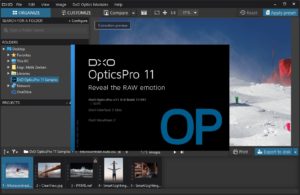
A crossed eye-icon in the noise-reduction panel is meant to warn you that the large pre-view isn't reliable.
#Dxo optics pro free pro
The preview image in DxO Optics Pro 9 looked better (not by much) but it turns out that you shouldn't rely on the preview with PRIME because it's too processor-intensive.
#Dxo optics pro free full
Without any noise reduction applied to the image, the test scene was full of ugly color and luminance noise. DxO claims a gain in image quality of up to 1 f-stop over the best noise-reduction algorithms currently on the market.Īs the proof of the pudding is in the eating, I decided to shoot a still life in a dimly lit room at ISO 6400 (that's as far as my Sony A700 will go). PRIME, an acronym for "Probabilistic Image Enhancement," analyzes the structure of RAW images in order to differentiate between noise and fine details. The number one new feature in DxO Optics Pro 9 is without a doubt the PRIME noise-reduction algorithm.

DxO Labs has hit the nail on the head! The new interface doesn't get in your way, looks gorgeous, and is efficient to use.

Every time I read that little sentence, I braced myself for yet another futile attempt at giving the main window as much screen real estate as possible, and every time I was disappointed-except this time. After having spent almost three weeks using it, I think this version could well make all other editors bite the dust.Įvery last version of DxO Optics Pro has been given an interface redesign. Version 9 has a redesigned interface, a unique noise-reduction feature, better DxO Smart Lighting capabilities, new visual presets, and improved export tools. Software Reduces Noise, Enhances Image QualityĭxO Labs has once again upgraded its flagship image editor, DxO Optics Pro.


 0 kommentar(er)
0 kommentar(er)
